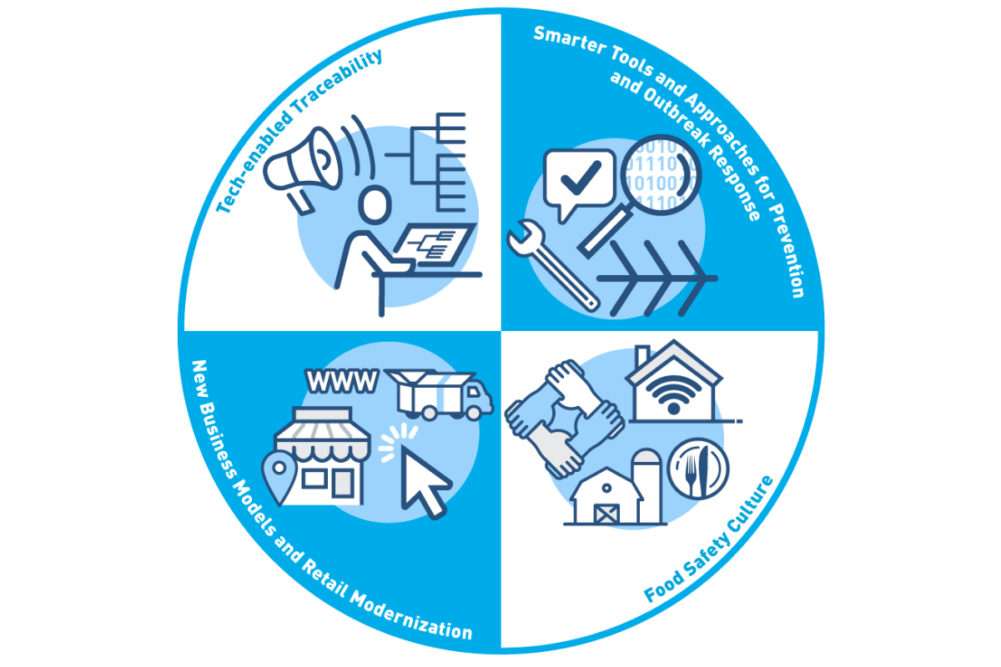WASHINGTON — The Food and Drug Administration on July 13 issued a “blueprint” that the agency said outlines the approach it will take over the next decade to usher in a New Era of Smarter Food Safety.
The release of the blueprint had been slated for March but was delayed as the FDA shifted gears to respond to the eruption of the coronavirus (COVID-19) pandemic.
“In the months that have followed, it has become even clearer — from our experiences with the pandemic and the lessons we have been learning as part of the FDA’s response to it — just how essential the actions outlined in this blueprint are, and, if anything, they are more important now than ever,” said Stephen M. Hahn, MD, FDA commissioner.
The FDA emphasized the blueprint builds on the FDA Food Safety Modernization Act and represents the next stage in the process of ensuring the safety of the US food supply.
Core sections of the blueprint address enhanced traceability, smarter tools and approaches for prevention and outbreak response, new business models and retail modernization, and a culture of food safety.
Dr. Hahn said one the challenges faced by the FDA over the years has been recurring outbreaks of illnesses associated with the consumption of certain foods.
“What this daunting problem underscores is the critical importance of FDA working with industry so that we can rapidly trace a contaminated food to its source,” Dr. Hahn said. “And when I say rapidly, I mean minutes, not days, weeks, or even longer.
“We want to explore ways to encourage companies to adopt tracing technologies and also to harmonize efforts to follow food from farm to table. We should strive to speak the same language, by espousing similar data standards across government and industry for tracking and tracing a food product.”
Dr. Hahn said enhanced traceability, coupled with advanced analytical tools, may help the FDA spot potential problems in advance and prevent or lessen their impact.
“One of our most important resources we have today lies in our ability to unleash the power of data,” Dr. Hahn explained. “We intend to do everything we can to attain better quality data, conduct more meaningful analysis of it, and to transform streams of data into more meaningful, strategic and prevention-oriented actions.”
Dr. Hahn said the FDA intends to strengthen procedures and protocols for conducting the root cause analyses that may identify how a food became contaminated and inform understanding of how to prevent such contamination from happening again.
The blueprint acknowledges that the pandemic has greatly accelerated the recent trend of consumers ordering groceries and meals online for home delivery.
“We must help ensure that as these foods travel to our front doors, they continue to be safe for consumers,” Dr. Hahn said. “That concept is important at any time, but COVID-19 has accelerated the need to establish best practices and an industry standard of care in this area.”
Other new business models include novel ways of producing foods and ingredients, such as cell-cultured food products.
“We intend to ensure that as food technology evolves, our oversight evolves along with it, to help ensure food safety,” Dr. Hahn asserted.
The blueprint also indicated the FDA will work to help modernize food safety at restaurants and other retail food outlets.
“Many restaurants and other retail outlets have had to temporarily close or change the way they do business during the pandemic,” Dr. Hahn said. “As they start back up and get their bearings, we intend to engage with the retail food industry and our partners in state government to help change practices, including a greater focus on how we motivate behavior changes by retail workers. We’ll also encourage and explore the use of new digital tools that will support food safety practices.”
The blueprint also includes a section on fostering the growth of a food safety culture on farms and in food facilities.
“The pandemic has given us a new perspective on what we mean by food safety culture,” Dr. Hahn said. “We still believe that to make dramatic reductions in foodborne disease, we must do more to influence and change human behavior, as well as to address how employees think about food safety, and how they demonstrate their commitment to this as part of their jobs.
“But a strong culture of food safety involves more than this. It’s also about keeping those food workers safe and about educating consumers, who are cooking more at home these days, on safe food handling practices.”
Leslie G. Sarasin, president and chief executive officer, FMI – The Food Industry Association, said, “On behalf of the retailers, wholesalers, product suppliers and other stakeholders within the FMI membership, I thank FDA for its leadership in designing a plan that creates a more digital, traceable and safer food system. We look forward to working with the agency on the implementation of its Smarter Food Safety plan.”






